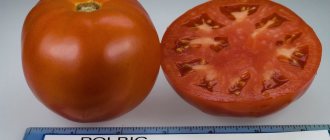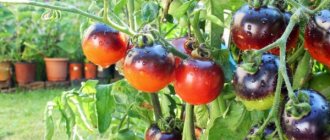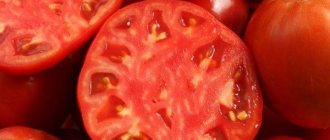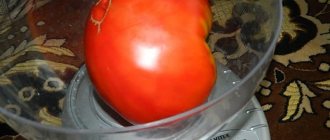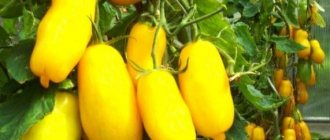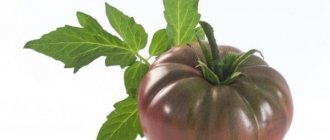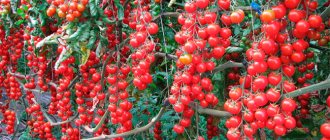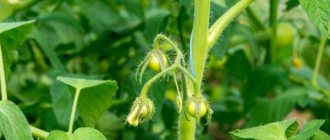Description of Niagara tomato variety
Tomato Niagara has an indeterminate growth type. The height of the bush is 1.5-1.8 m. The root system of the plant is strong, but the stem is thin, so it is necessary to grow it on a support in the form of stakes or with a garter to a trellis.
Despite the waterfall of fruits, Niagara forms a compact bush
The manufacturer recommends growing Niagara tomato with 1-2 stems, but according to reviews from gardeners, the crop develops well and bears fruit with a more branched formation - 3-4 stems. The leaves are medium sized and green. The inflorescences are simple.
Important! When growing Niagara tomatoes, it is necessary to apply an increased amount of fertilizing.
The variety is intended for growing indoors, but also performs well in open beds with a protective film in case of bad weather and cold snaps. It is distinguished by good fruit set, including at various temperature deviations. Fruiting is abundant, extended, and occurs from July to August.
Description of fruits
The fruits have a beautiful elongated shape, like cream with a spout. The average weight is about 95 g. The size of one tomato can reach 120 g if the amount of ovary is rationed and formed into one stem. Multiple clusters - from 10 to 14 tomatoes each. Unripe tomatoes are green in color, while ripe ones are red. The pulp is fleshy, with few seeds.
The taste of tomatoes is delicate, the characteristic sourness is almost not felt
The fruits are decorative and aligned throughout the bush. The surface is smooth, the skin is dense, and there are 2-3 seed chambers inside. Tomatoes tend to fall off the hand even from a light touch, but are not damaged.
The dense, non-watery fruits withstand long-term storage well, during which they may only dry out somewhat. They tolerate transportation well.
What to look for when growing tomatoes
All those who have at least once in their life been involved in growing tomatoes on their plot know very well that achieving a positive result largely depends on the correct planting of seeds. The rule is valid both for greenhouse cultivation and for ordinary cultivation in open ground. Niagara seeds, according to reviews from gardeners who have personally grown them, do not germinate particularly well. As a rule, half of the total number of seeds planted germinates. That is why planting density plays a role.
Have the seeds sprouted? Fine. Now future seedlings need to be provided with sufficient lighting - at least 16 hours under a special “phyto-lamp”. Buying a fluorescent lamp for greenhouses is now relatively simple. In any specialized store, sources of gentle artificial light are offered in a wide range. We are talking about both the shape and the power of the lamp. The price remains at an affordable level.
After the future “tomato” bushes are strong enough, they can be planted in the garden under the open sky. Special care is no longer required here. If desired, given that from one bush you can collect from 8 to 10 kilograms of “extended cream”, you can “feed” the plant with the usual organic fertilizers.
Important point: vegetables stick very poorly to the bush
Yes, falling does not mean rapid spoilage, and the tomatoes lie very well, but both watering and harvesting require caution and attention
Characteristics of Niagara tomato variety
The Niagara tomato is a variety produced in Siberia, taking into account the climate and short summer of the region. It is characterized by stable and high yield. The plant produces tomatoes well until the coldest weather. Forms dense clusters with same-sized tomatoes. The ripening period is average, the first fruits are formed three months after sowing.
Tomatoes ripen unevenly, ripen well indoors, and do not spoil. The crop is successfully grown both in a greenhouse and outdoors under temporary shelters. The characteristics of the yield and commercial qualities of the fruit make it possible to cultivate the Niagara tomato not only for personal, but also for commercial purposes.
Niagara tomato yield and fruiting
The yield in greenhouses is 10 kg per plant. On an open ridge, the productivity of Niagara tomato is lower. Fruiting is extended, the ovaries form the entire warm period. Tomatoes ripen on the bush when grown in a greenhouse. In outdoor conditions, especially in cold regions, tomatoes do not have time to ripen on the bush.
Area of application of fruits
Niagara plum tomatoes are one of the best fruits for pickling due to their suitable consistency and thick skin. When preserved as a whole fruit, they do not crack and have a good taste. Also suitable for making tomato paste.
Resistance to diseases and pests
The variety is not susceptible to blossom end rot. The plant is hardy, resistant to temperature changes. But with prolonged high humidity or improper care, it is vulnerable to fungal diseases.
Plant care
Summer residents and vegetable growers prefer Niagara tomatoes, mainly because this variety is unpretentious and resistant to diseases and parasites. It does not require special care. But still, planned care procedures need to be carried out. These include
- Watering
- Loosening the soil
- Weeding
- Treatment against pests and parasites
- Soil fertilization
- Removing stepchildren
- Removing excess leaves
- Harvesting
Watering your tomato garden should be done no more than once a week. Treatment against parasites and pests is carried out every 10-12 days. Fertilizer is also done every 12-15 days. At the beginning of summer, plants need to be fertilized with nitrogen fertilizers and so on until the middle. After these fertilizers, you can start feeding with potassium and phosphorus fertilizers. This way the fruits will get a rich taste.
Niagara has an indeterminate bush, the height of which reaches 150-180 cm. The tassels on the plant are tied through one internode. In total, there can be 5-8 similar clusters on a bush and each has up to 10 fruits.
Bush formation
Fruiting of plants lasts for more than a month. Multi-colored lashes of fruits of different ripeness look like a cascade of waterfalls, which determined the name of the variety - Niagara.
Bushes are formed into 1, 2, 3 and even 4 stems. The higher this number, the smaller the size of the fruit, but this does not affect the overall yield, although, of course, it delays the onset of ripening. And here there is a choice: who likes what more. However, different bushes can be shaped in different ways.
Ripening time
The time from the first shoots to the first harvest ranges on average from 105 to 115 days, which makes it possible to classify Niagara as a mid-season variety. And this is also the golden mean. The more early the variety is, the lower its yield.
On the other hand, high-yielding hybrids with late ripening periods always run the risk of falling under the wave of late summer late blight, and then the entire harvest will be lost.
It includes weeding, watering, loosening the soil to aerate the root system, and forming a bush with pinching.
Stepsoning
This operation is carried out as follows. A stepson is left above the 1st flower cluster, from which the 2nd stem will grow. If necessary, the 3rd stem is formed from the stepson above the 2nd flower raceme on the main stem. All extra stepsons are removed.
Top dressing
Produced with a full complex of NPK fertilizers (nitrogen, phosphorus, potassium). One teaspoon of this fat is added to the hole when planting, mixing with the soil. The second time it is used at the flowering stage. Nitrogen is excluded from the third feeding during fruit formation.
Advantages and disadvantages of the variety
Tomato Niagara is a young plum-shaped variety. The fruits have an original shape and look decorative both on the plant and when pickled.
pros
- stable yield;
- compact bush;
- same size of fruits;
- possibility of long-term storage;
- tomatoes are suitable for transportation;
- resistance to weather changes;
- possibility of growing with collected seeds;
- not susceptible to blossom end rot.
Minuses
- uneven ripening of tomatoes;
- low and long seed germination;
- fruit falling from the bush.
The Niagara tomato variety is suitable for different growing conditions, personal and industrial purposes.
To obtain smooth, beautiful tomatoes, monthly feeding is required.
For cultivation, multiple garters of stems are required.
Positive and negative sides
This variety has a number of advantages:
- Tolerates temperature changes well. Fruit ripening is not affected by heat or cold, so the variety is suitable for most regions.
- Excellent yield.
- Long fruiting - from 1 to 1.5 months.
- Resistant to many pests and diseases.
- Long-term storage. The fruits are stored until winter. At the same time, the taste and appearance do not deteriorate.
- Easy to care for.
Among the disadvantages are:
- Poor seed germination. Out of ten seeds planted, only one can sprout. This indicator can be improved by additionally treating the seeds in peroxide.
- Regular tying of bushes throughout fruiting.
- Fragility of fruit clusters. If ripe tomatoes are not picked in time, they will fall off at the slightest touch or even gusts of wind.
Features of cultivation
Tomato Niagara is grown in seedlings. Sowing begins 2.5 months before transplanting to the main place in open ground or a greenhouse. The seeds of the variety have low germination, so it is necessary to carry out pre-sowing preparation. They are soaked in a solution of drugs that improve germination, for example, Energen Aqua.
In order to find out the percentage of living seeds, they are first germinated in a damp cloth. After the sprout appears, the seeds are carefully transferred to the soil using tweezers. During the seedling period, Niagara tomato seedlings look weaker than varieties with powerful stems, but when transferred to a permanent growing site, the plants take root well.
The soil for sowing is prepared fertile and porous. Coconut tablets are well suited for sprouting Niagara tomatoes.
The substrate is neutral in acidity, does not support pathogenic microflora, absorbs and retains moisture well
The time for the appearance of the above-ground part of the plant is longer than that of other varieties. During this entire period, the seedlings are kept at temperatures above +20°C. Then it is transferred under lamps with special lighting for plants.
When true leaves appear, the seedlings are transferred to containers with a large amount of soil. During transplantation, they try not to affect the root system; when grown in coconut tablets, the plants are transferred along with the substrate.
Advice! Do not use tap water for watering seedlings, only settled or melted water at a temperature above room temperature.
To transplant into a greenhouse, the soil in it is dug up, loosened and fertilized. The Niagara variety can be planted compactly - 3-4 plants per 1 square meter. m. But for better ventilation and nutrition, it is most favorable to choose a more spacious planting. After transplantation, the bushes are immediately tied up and, if necessary, temporarily shaded.
The plant is suitable for forming 1-4 stems, the remaining stepsons are removed. The leaves located below the brush, on which the fruits have already begun to ripen, are also torn off.
Water the bushes in the root zone. Fertilizing is applied as soon as the plant gets stronger after transplantation. In the first half of the growing season, bushes need nitrogen and phosphorus, in the second half - phosphorus and potassium. During the period of growth and fruit filling, the crop needs boron and magnesium, which are delivered by spraying on the leaf.
Features of planting and care
There are several useful recommendations for proper planting of Niagara tomatoes and further care that will help increase the percentage of germination and ensure maximum yield.
Planting Niagara tomatoes should be done in the following sequence:
- At the beginning of March, it is good to warm the soil in the greenhouse and fertilize it with complex mixtures.
- Make holes 1 cm deep, keeping a distance of 4-5 cm between planting units.
- Place the seeds into moist soil. Usually about 20-25% of seeds germinate.
- After 2-3 true leaves appear, you can begin picking and replanting in open ground.
- Choose a well-lit, draft-free place.
- Add inorganic fertilizers to the soil in advance and, having dug small holes at a distance of 20-25 cm, plant the seedlings in open ground.
- Provide all conditions for further growth of seedlings.
In order for the Niagara tomato variety to meet all expectations and present a rich harvest, you must follow all the rules for caring for the plant:
- After planting, it is necessary to carefully monitor the growth of the plant and regularly check it for the presence of characteristic symptoms of diseases and pests.
- Carry out at least three feedings: the first - after a week after planting, the second - when the plant begins to bloom, and the third - during the fruiting period.
- It is better to use phosphorus and potassium mixtures as fertilizers.
- Trim the plant regularly, leaving only 2 stems. If there are more of them, the plant will spend a lot of nutrients on their maintenance, and not on the development of fruits. Therefore, to obtain large tomatoes, it is better to leave only one stem after forming pruning.
- Regularly tie up the plant, since heavy stress on fragile stems due to massive fruits can negatively affect garden crops. A lot of energy will be spent not on shaping the tomatoes, but on strengthening the branches, which, in the absence of additional resources, may break off.
- If after pruning there is only one trunk left, then the plant does not need to be fixed to a support, since it will be strong enough to support the mass of fruits.
- Watering should be carried out no more than 1-2 times a week, using warm water. Apply the liquid under each bush directly to the surface of the root system.
- After watering, loosen the soil and remove all weeds. In rainy weather, avoid this procedure, as excess moisture can provoke the development of late blight on garden crops.
Details about the correct formation of tall tomato varieties:
Important! When harvesting, you should be especially careful when removing light red fruits, since even a light touch can cause green tomatoes to fall off.
You should not allow the tomatoes to turn a deep red color or overripe them. This may slow down the growth of the remaining tomatoes.
Advice! The main thing in caring for Niagara tomatoes is to do everything on time and according to generally accepted rules.
Pest and disease control
Plants with good immunity are less susceptible to diseases. When growing Niagara tomatoes, it is recommended to use balanced compositions of microelements, for example, Orton Micro-Fe.
To maintain plant health, limit the application of nitrogen and organic fertilizers. To prevent fungal diseases, do not water tomatoes in cool weather.
If infection occurs, use Bordeaux mixture.
The bushes are treated with the Fitoverm insecticide against various types of pests.
Treatments are repeated every 3-7 days.
